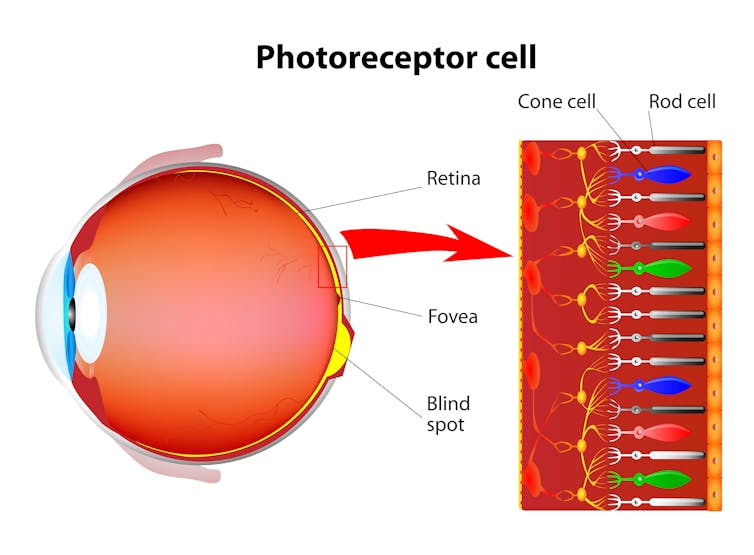Curious Kids is a series for children. If you have a question you’d like an expert to answer, send it to [email protected] You might also like the podcast Imagine This, a co-production between ABC KIDS listen and The Conversation, based on Curious Kids.
My name is Abhilasa. I am 10 years old and I live in Melbourne. My question is: Why are people colour blind? – Abhilasa, age 10, Melbourne.
Hi Abhilasa. Thank you for your great question.
Let’s say you have three tubs of paint: blue, green and red. You have a paintbrush and a piece of paper. You can use the three paints to make lots of different things. A green tree, a blue car, or a red apple. And if you want to paint a purple shirt, you can mix red and blue paint to make purple.
How do we see those different colours? In your eye you have special kinds of cells that pick up the light rays bouncing off each splotch of paint. These cells are called cone cells.
In the microscope, they look like ice-cream cones. But they are much smaller. The cone cells help you see the different colours.
There are three kinds of cone cell in most people’s eyes. They are called long wave cones, medium wave cones, and short wave cones, because they pick up different kinds of light waves (or rays).
The cone cells tell the brain how much of each type of light wave is bouncing off each splotch of paint.
Your brain puts those messages back together again.
So let’s say you mix red and blue paint to make a purple splotch. Lots of long and short wave light will bounce off that splotch, but not much medium wave light will (the reason this happens is hard to explain, but you just have to trust me that this is how light works). Then the long and short cones in your eyes get activated, and will send their message to the brain. The brain interprets the message and voilà! The splotch will look purple to you.
Colour blind people can still can see colours, but not as many as most people do. That’s because the cone cells in their eyes may be different.
There are three kinds of cone cells in most people’s eyes. Shutterstock
Some colour blind people only have two kinds of cone cell in their eye. Others have three kinds, but the cones do not pick up the same light waves as the cone cells in most people’s eyes do. So their brain does not get three different messages like most people’s brains do.
Being colour blind is a bit like what would happen if I took away one of your tubs of paint, so you only have two tubs. You could still make some different-coloured splotches, but not as many as when you had three tubs. That would not be so much fun. Being colour blind is sometimes not much fun either. Some kids laugh in school when colour blind kids get their coloured pencils mixed up. That’s mean.
But being colour blind can be good, too. Colour blind people are really good at spotting things that are far away, and they are better than most people at telling things apart by their shape.

Please tell us your name, age and which city you live in. You can send an audio recording of your question too, if you want. Send as many questions as you like! We won’t be able to answer every question but we will do our best.



 Trump Backs Review of U.S. Childhood Vaccine Schedule After Hepatitis B Policy Change
Trump Backs Review of U.S. Childhood Vaccine Schedule After Hepatitis B Policy Change  Eli Lilly’s Weight-Loss Pill Nears Fast-Track FDA Approval as Profits Surge on Global Demand
Eli Lilly’s Weight-Loss Pill Nears Fast-Track FDA Approval as Profits Surge on Global Demand  FDA Adds Fatal Risk Warning to J&J and Legend Biotech’s Carvykti Cancer Therapy
FDA Adds Fatal Risk Warning to J&J and Legend Biotech’s Carvykti Cancer Therapy  Novo Nordisk Appoints Greg Miley to Lead Corporate Affairs Amid U.S. Drug Pricing Pressure
Novo Nordisk Appoints Greg Miley to Lead Corporate Affairs Amid U.S. Drug Pricing Pressure  Canada Loses Measles-Free Status After Nearly 30 Years Amid Declining Vaccination Rates
Canada Loses Measles-Free Status After Nearly 30 Years Amid Declining Vaccination Rates  Eli Lilly’s Inluriyo Gains FDA Approval for Advanced Breast Cancer Treatment
Eli Lilly’s Inluriyo Gains FDA Approval for Advanced Breast Cancer Treatment  Novo Nordisk Appoints Greg Miley as Global Head of Corporate Affairs Amid U.S. Pricing Pressure
Novo Nordisk Appoints Greg Miley as Global Head of Corporate Affairs Amid U.S. Pricing Pressure  Cogent Biosciences Soars 120% on Breakthrough Phase 3 Results for Bezuclastinib in GIST Treatment
Cogent Biosciences Soars 120% on Breakthrough Phase 3 Results for Bezuclastinib in GIST Treatment  Trump Hints at Major Autism Announcement, Raises Questions on Tylenol Link
Trump Hints at Major Autism Announcement, Raises Questions on Tylenol Link  Merck Nears Acquisition of Cidara Therapeutics at Significant Premium
Merck Nears Acquisition of Cidara Therapeutics at Significant Premium  U.S. Backs Bayer in Supreme Court Battle Over Roundup Cancer Lawsuits
U.S. Backs Bayer in Supreme Court Battle Over Roundup Cancer Lawsuits  Pfizer Sues Novo Nordisk Over Alleged Tactics to Block Obesity Drug Competition
Pfizer Sues Novo Nordisk Over Alleged Tactics to Block Obesity Drug Competition  Trump Administration to Launch Autism Initiatives Targeting Acetaminophen Use and New Treatment Options
Trump Administration to Launch Autism Initiatives Targeting Acetaminophen Use and New Treatment Options  U.S. Reveals 2026 Medicare Star Ratings: Aetna, UnitedHealth Lead in Quality Scores
U.S. Reveals 2026 Medicare Star Ratings: Aetna, UnitedHealth Lead in Quality Scores 
































